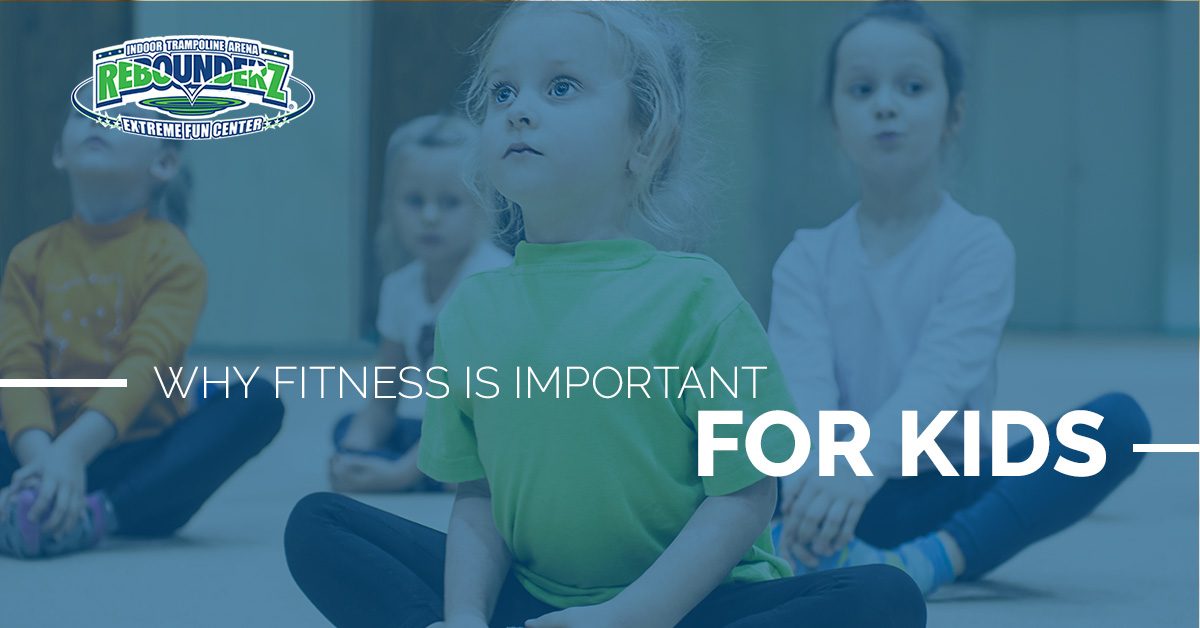ENJOY FREE ADMISSION EVERY DAY WHEN YOU PURCHASE A REBOUNDERZ MEMBERSHIP!

Call Us Now: (833) 832-1255
ENJOY FREE ADMISSION EVERY DAY WHEN YOU PURCHASE A REBOUNDERZ MEMBERSHIP!

Call Us Now: (833) 832-1255

With childhood obesity on the rise, it is more and more important for kids to be physically active. Physical activity doesn’t have to be in a gym or in physical education class at school, though. Running around at recess, playing sports, and riding bikes are all wonderful forms of physical activity that help kids stay healthy. Today, we’re going to take a closer look at why fitness is so important for children. One of the most fun ways you can make sure your kids are getting active is right here at Rebounderz Trampoline Park. Whether they’re running through our exciting Ninja Warrior course or they’re jumping on our safe trampolines, they’re exercising while they have fun. Without further ado, let’s jump into the importance of fitness for kids.
While everyone, regardless of their age, benefits from regularly exercising, kids stand to benefit even more. As their bodies are growing, it’s important that they stay active to get these benefits:
Not only will a child receive those benefits, they will also sleep better after burning off excess energy. That means they’ll be more alert and attentive in school, ready to learn. They’ll also be better equipped to handle both physical and emotional challenges, whether it’s running to catch their bus or studying for a big test the next day. Kids need a lot of sleep to develop properly, so physical activity will ensure they’re ready for bed.
Regardless of if it’s on the playground or in the gym, you can distill fitness down to three separate forms. These forms can combine in different types of activity, but for the most part, you can break them down like this:
It’s a good idea to encourage your children to try a variety of physical activities so they can work on all three forms of fitness. This will help them be well rounded in their health and activity. Let’s take a deeper look at each of the three forms, shall we?
This form is developed when kids get regular aerobic and cardiovascular exercise. When engaging in aerobic activity, heart rate increases and you’re breathing harder. When this is done on a regular basis, it strengthens the heart, improves blood flow, and makes it easier for the body to receive the oxygen and nutrients it needs to be healthy and strong. Aerobic exercise is fun for everyone, no matter what your age is. Some examples of endurance-boosting aerobic activity include:
When we talk about kids improving their strength, we’re not implying they need to become muscle-bound after lifting weights. Rather, they can do this with some simple exercises. Boosting their strength will ensure they build healthy muscles, joints, and bones. This training also helps to strengthen the ligaments and tendons that provide support for muscles and bones, while also improving bone density. Some strength-building activities include:
Placing an importance on flexibility won’t just help kids be more active, it will also help them avoid injuring themselves while they play. Muscles have a natural elasticity that is necessary to move. When your child learns proper stretching techniques, they’re able to move through their full range of motion without trouble. Stretching before and after physical activity will help their muscles adjust to what will be asked of them to avoid strains or pulled muscles. Some helpful and easy stretches include:
As of 2015, nearly one in five school-aged children and young people (from six to 19 years of age) had obesity. It’s clear to see that as an epidemic, but it’s something that parents can help their children avoid. With a connection to the internet in everyone’s pocket and a constant barrage of different media to consume, kids have fallen into an increasingly sedentary lifestyle. A few ways to help your kids be more active include:
When parents are told they need to ensure their kids are getting enough physical activity, it can feel like a nebulous concept. How much is enough? How much would be too much? Luckily, the National Association for Sport and Physical Education put together some helpful guidelines for infants, toddlers, preschoolers, and school-age kids.
No specific time requirements. Encourage physical activity to strengthen the development of motor skills.
Recommended minimum daily activity- Hour and a half. Break it up between 30 minutes of planned physical activity and 60 minutes of unstructured physical activity (play time).
Recommended minimum daily activity- Two hours. 60 minutes of planned physical activity and 60 minutes of unstructured physical activity (play time).
Recommended minimum daily activity- One hour or more. Break this up into 15-minute activities to work around their new school schedule.
Helping your child stay fit will have long-lasting effects as they grow up. Their bones, joints, and muscles will be strong and avoid injury thanks to their improved flexibility. They’ll be less likely to get tired after short activities with their boosted endurance. Your child will also sleep better after working out excess energy. If you’re looking for someplace fun for your kid to be physically active, bring them to Rebounderz here in Sunrise. They can spring into our foam pit or test their basketball skills on the SlamBall court. No matter what they choose, you can be sure they’re getting the physical activity they need to grow up big and strong. We hope you jump in soon!